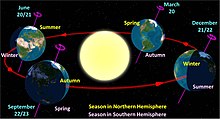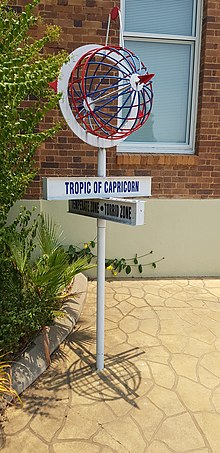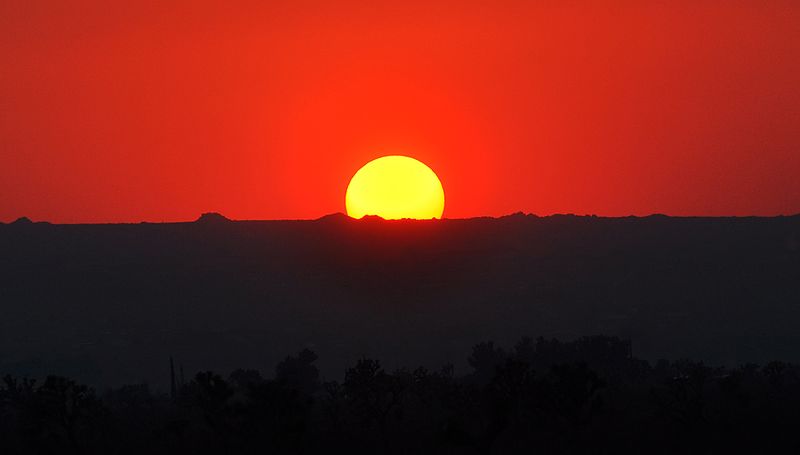The
summer solstice, also known as
estival solstice or
midsummer, occurs when one of the Earth's poles has its maximum tilt toward the Sun. It happens twice yearly, once in each hemisphere (Northern and Southern). For that hemisphere, the summer solstice is when the Sun reaches its highest position in the sky and is the day with the longest period of daylight. Within the Arctic circle (for the northern hemisphere) or Antarctic circle (for the southern hemisphere), there is continuous daylight around the summer solstice. On the summer solstice, Earth's maximum axial tilt toward the Sun is 23.44°. Likewise, the Sun's declination from the celestial equator is 23.44°.

|
|
The Earth during the summer solstice in June 2017
|
The summer solstice occurs during summer. This is the June solstice in the Northern Hemisphere and the December solstice in the Southern Hemisphere. Depending on the shift of the calendar, the summer solstice occurs sometime between June 20 and June 22 in the Northern Hemisphere and between December 20 and December 23 in the Southern Hemisphere. The same dates in the opposite hemisphere are referred to as the winter solstice.
Since prehistory, the summer solstice has been seen as a significant time of year in many cultures, and has been marked by festivals and rituals. Traditionally, in many temperate regions (especially Europe), the summer solstice is seen as the middle of summer and referred to as "midsummer". Today, however, in some countries and calendars it is seen as the beginning of summer.
Distinctions

|
|
Diagram of the Earth's seasons as seen from the north. Far left: summer solstice for the Northern Hemisphere. Front right: summer solstice for the Southern Hemisphere.
|

|
|
Longreach, Queensland at mid-day of summer solstice 2019. The town is on the Tropic of Capricorn (Shadow directly below the sign)
Solstice is derived from the Latin words sol (Sun) and sistere (to stand still).
|
Although the summer solstice is the longest day of the year for that hemisphere, the dates of earliest sunrise and latest sunset vary by a few days. This is because the Earth orbits the Sun in an ellipse, and its orbital speed varies slightly during the year.
Further information:
Equation of Time
Although the Sun appears at its highest altitude from the viewpoint of an observer in outer space or a terrestrial observer outside tropical latitudes, the highest altitude occurs on a different day for certain locations in the tropics, specifically those where the Sun is directly overhead (maximum 90 degrees elevation) at the subsolar point. This day occurs twice each year for all locations between the Tropic of Cancer and Tropic of Capricorn because the overhead Sun appears to cross a given latitude once before the day of the solstice and once afterward. For example, Lahaina Noon occurs in May and July in Hawaii. See solstice article. For all observers, the apparent position of the noon Sun is at its most northerly point on the June solstice and most southerly on the December solstice.
Full moon
2016 was the first time in nearly 70 years that a full moon and the Northern Hemisphere's summer solstice occurred on the same day. The 2016 summer solstice's full moon rose just as the Sun set.
Cultural aspects

|
|
Summer solstice sunset over the Mojave Desert 7:54 p.m. PDT (19:54) June 20, 2016
|
The significance given to the summer solstice has varied among cultures, but most recognize the event in some way with holidays, festivals, and rituals around that time with themes of religion or fertility. For example, in Sweden, midsummer is one of the year's major holidays when the country closes down as much as during Christmas. In some regions, the summer solstice is seen as the beginning of summer and the end of spring. In other cultural conventions, the solstice is closer to the middle of summer.
Date

|
|
Date of the northern hemisphere's summer solstice over time. The ~25 drops per century are leap years when the date shifts back one day due to the insertion of February 29. There was no leap year in 1800 or 1900, which explains why there is no drop those years.
|




